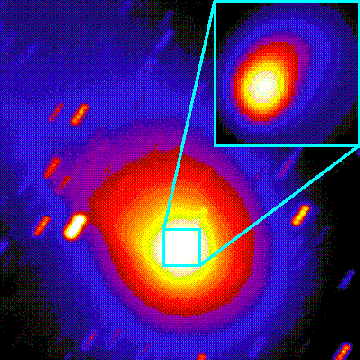Astronomy Picture of the Day
Discover the cosmos! Each day a different image or photograph of our
fascinating universe is featured, along with a brief explanation written by
a professional astronomer.
February 19, 1996

Periodic Comet Swift-Tuttle
Credit:
D. McDavid
(Limber Observatory),
D.C. Boice (SwRI)
Explanation:
Comet Swift-Tuttle,
shown above in
false color,
is the largest object known to make repeated
passes near the Earth.
It is also one of the oldest known
periodic
comets with
sightings spanning two millennia. Last seen in 1862, its reappearance in
1992 was not spectacular, but the comet did become bright enough to see
from many locations with binoculars.
To create this composite
telescopic image,
four separate exposures have been combined, compensating
for the motion of the comet. As a result, the stars appear
slightly trailed.
The inset shows details of the central coma.
The unseen nucleus itself is
essentially a chunk of dirty ice about ten kilometers in diameter.
Comets
usually originate in the Oort cloud in the distant
Solar System - well past
Pluto, most never
venturing into the inner Solar System.
When perturbed - perhaps by the gravity of a nearby star - a
comet may fall toward the Sun.
As a
comet
approaches the Sun, rocks, ice-chunks, gas, and
dust boil away, sometimes creating
impressive looking tails. In fact,
debris from Comet Swift-Tuttle is responsible for the
Perseids meteor
shower visible every July and August. Comet Swift-Tuttle is expected to
make an impressive pass near the earth in the year 2126, possibly similar
to
Comet Hyakutake this year or
Comet Hale-Bopp next year.
Tomorrow's picture: ASCA X-Ray Observatory
| Archive
| Index
| Search
| Glossary
| Education
| About APOD |




Authors & editors:
Robert Nemiroff
(GMU) &
Jerry
Bonnell (USRA).
NASA Technical Rep.:
Sherri
Calvo.
Specific rights apply.
A service of:
LHEA
at
NASA/
GSFC




